 Loose Connections
Loose Connections
On Sunday, March 5, I went looking for my shakerful of Robert Heinecken.
The Museum of Modern Art had scheduled its long-overdue but nonetheless welcome Heinecken retrospective, “Object Matter,” for the next evening, March 6, and — having participated in last year’s “Scholar’s Day” devoted to his work at MoMA — I’d received an invitation to the VIP opening.
Before he passed, on May 18, 2006, Bob willed that he be cremated. And editioned. His widow, Joyce Neimanas, fulfilled both requests, and in due time (with no forewarning) I received one of 200 numbered and signed salt shakers containing a portion of Bob’s remains.
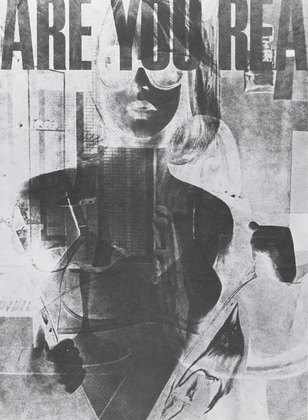
Robert Heinecken (American, 1931–2006). “Are You Rea” #1, 1964–68, lithograph
It occurred to me that Bob might like to be present in the flesh (or what remained of it) at his big New York opening, so I thought I’d bring the shaker along, to decide when I got there whether or not to disclose his presence to others or keep it our secret. In the event, the box containing the shaker wasn’t where I last remembered placing it, which I took as a sign — perhaps even from Bob himself, though he loved shaking things up — that this wasn’t a good idea. So I called off the search and went without him.
It felt like old home week. Joy was there, of course, along with Luke Batten, who now manages his estate. Carl Chiarenza, looking hale after two open-heart surgeries. Rod Lazorik. Eileen Cowin (and her twin sister, whom I hugged by mistake). And Robert’s work lining the walls and filling the vitrines, where it’s belonged for so many years, its prophecies fulfilled by others whose exhibitions there had preceded his, in galleries filled with young people who will never know experientially how explosively his actions resonated in the medium’s field of ideas at the moments he chose for his interventions.
Balamer and Back
We’ve already had crocus up in the garden and daffodils poking through, but Staten Island Chuck got it right on February 2: six more weeks. Indeed, he proved himself an optimist; seven and counting, by our measure. Drawing to a close, we hope; Anna and I have grown tired of feeling warm and cozy but cooped up.

I did get out of town for a few days, traveling by bus down to Baltimore for the 51st Society for Photographic Education National Conference, March 6-9. I hadn’t been in Baltimore since early 2008, when I went down by train to participate in the memorial service for my friend and colleague Richard Kirstel, only to discover that I’d mistaken the date and arrived a day late.
I went to receive the organization’s lone 2014 Insight Award. Previous recipients include Sant Khalsa (2012) and the 2013 bumper crop of Ken Josephson, Nathan Lyons, Elaine Mayes, Jerry Uelsmannn, Jack Wilgus, and Cheryl Younger.
For those of you not familiar with the organization, the SPE is the nation’s (and the world’s) oldest and largest organization of photo students. Once a professional organization, membership in which merited inclusion on one’s CV, it transformed itself incrementally — with the approval of the majority of its members — into the Audubon Society of photography: $25 and an interest in birds and you’re a member (and they’ll waive the interest in birds).
They allow photo teachers to join, since almost without exception they’re former photo students themselves; additionally, they’re needed to supervise and entertain the hordes of student attendees. Even professionals in other branches of the medium who don’t teach, or (like me) do so only part-time — curators, critics, historians, etc. — can join and attend, though few do nowadays.
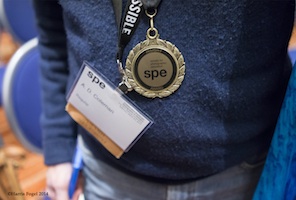
ADC with Insight Award medal, SPE, Baltimore, March 7, 2014. Photo © by Harris Fogel.
Given that more than half the attendees are adolescents, something of the ethos and atmosphere of summer camp prevails, with faculty cast in the role of counselors. (Virginia Morrison, SPE’s Executive Director, made that official in her opening remarks by greeting us as “our inspired community of photo-campers.”) I’m told that shepherding ever larger clusters of students through the conference has actually become contractually mandatory for many photo teachers. I can’t imagine why; in no other art form’s post-secondary educational system do departments schedule student attendance at such a gathering, or require faculty to serve as chaperones.
So this gathering of teachers and students, effectively a quickie student-faculty exchange program, proves unique to photography. Like the one-on-one 20-minute portfolio reviews offered by many photo festivals and sometimes as stand-alone events, a form of speed-dating that occurs in no other medium. (I just participated in one sponsored by the ASMP NY, the local branch of the American Society of Media Photographers, whose process gives reviewer and reviewee just a 10-minute f2f.)
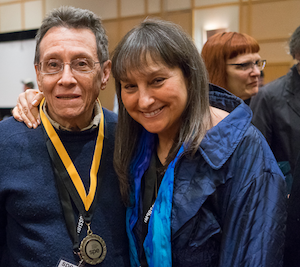
ADC with Suzie Katz of PhotoWings, SPE, Baltimore, March 7, 2014. Photo © by Harris Fogel.
The SPE National Conference includes portfolio reviews, by far the most popular items on the program. Many come just for that, forgoing the lectures, panels, and other menu items in order to stand on line — students and teachers alike — to receive brief commentary on their work from … mostly photo teachers. Beats me.
I heard some very good lectures, most of them under-attended. In one of these, Colleen Mullins, who’d taken a summer workshop with me at the Penland School of Crafts a decade ago, offered a spirited defense of for-profit art schools, a subject on which I’m woefully uninformed and have no opinions.
After congratulating Colleen on her talk I took a bathroom break and headed to another, shook hands with a few people, and got intercepted by someone I’d never met or known of till then. She’d heard someone mention that I was a critic, obviously had never read any of my work, but wondered if she could pick my brain about a project of hers.
I said sure, so we found some comfortable chairs in a quiet corner. As we sat down, a picture postcard fell out of her bag. I recognized the image on it immediately — a portrait of a young woman by a photographer of my acquaintance. The back contained a short narrative of the making of that picture, in 1971, but neither the front nor back of the card bore his name.
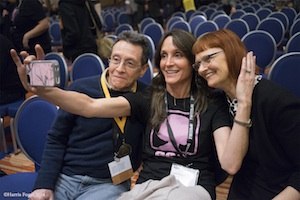
ADC with Linda Roberts (m) and Susan kae Grant (r), SPE, Baltimore, March 7, 2014. Photo © by Harris Fogel.
“Where did you get this?” I asked. “There’s a stack of them out on the conference’s notices table,” she replied. “Why?” “Because I know this photographer, and I know this picture.” Agreeing to take this as a signal that fate had ordained our meeting, we proceeded with our consultation.
•
Then I went to hear a talk by Catherine Lord, whom I’d last seen at SPE during the 1986 national conference in Baltimore. I’d resigned from the organization shortly thereafter, in an open letter that the SPE Board refused to publish, in protest against the Board’s censure of the conference organizers, Frank Rehak and Richard Kirstel, an act into which the Board had been bullied by the Women’s Caucus of the SPE, of which Lord was one of the leading voices. (I wouldn’t rejoin the organization until 1997.)
The last time I’d heard Lord speak was at a College Art Association annual conference in Los Angeles, when she’d been on a panel, explaining a sexual-harrassment charge lodged against her by a female student. She’s a very good speaker, measured and persuasive. Her SPE talk dealt at some length with the organization’s history and the formation of the Women’s Caucus. In it she derided Heinecken (without naming him) for wearing a ponytail and cowboy boots, not mentioning that at the time she and some of her cohorts affected black leather jackets and boots.
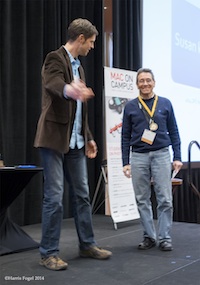
ADC with Michael Marshall, SPE, Baltimore, March 7, 2014. Photo © by Harris Fogel.
Though I disagree fundamentally with her version of the events of that period, her talk confirmed something I already knew — that any situation can engender multiple plausible narratives, and that truth (perhaps even complete truth) can reside in more than one of them. Still, I couldn’t help remembering Heinecken getting himself bodily carried out of a Women’s Caucus meeting in the 1980s, simply for attending (men were not invited).
•
I put a lot of energy into the SPE during certain phases of my work, before bowing to the inevitable and giving up on it. Nice to get this award: collegial recognition, public and private, matters. Criticism’s largely a thankless task, beyond the pleasures of craftsmanship and the sense of having fulfilled your citizenly duty. In the absence of support, I’ll settle for encouragement. (My motto, one of them: Lip service is better than no service at all.)
Michael Marshall, Chair of the SPE’s National Board, presented the Insight Award award to me on the evening of March 7. To my astonishment, as I walked onto the stage I received a standing ovation — the first ever.
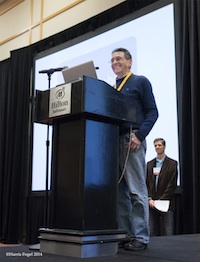
ADC at podium, SPE, Baltimore, March 7, 2014. Photo © by Harris Fogel.
Turns out the Insight Award is an actual bronze medal on a ribbon, which he hung around my neck. (Marshall towers over me by something like 18 inches, so this had its comical aspect.) In addition to giving me the medal, the organization allotted me 1-2 minutes for comments. Here’s what I said:
I’m honored that the Society for Photographic Education has selected me to receive this Insight Award.
I attended my first SPE conference in New York in the early 1970s. I couldn’t have envisioned then what the organization would become, much less that I’d be standing here tonight for this occasion.
For several years in the 1970s I taught at the Maryland Institute, College of Art as a visiting critic. So I enjoy the fact that MICA has co-sponsored this conference.
My thanks to Harris Fogel of the University of the Arts in Philadelphia, my friend and colleague and publisher (and former intern, and former employer), who nominated me for the Insight Award. Thanks also to the SPE’s Board of Directors, who approved it. I take that in part as the Board’s expression of its appreciation for my not writing them any letters or making trouble at membership meetings since 2007.
In closing, I dedicate this award to the memory of two friends, colleagues, and long-term members of the SPE who influenced my thinking about photography, and have passed on — the teaching artists Richard Kirstel, for many years on the MICA faculty, and Robert Heinecken.
Thank you.
•
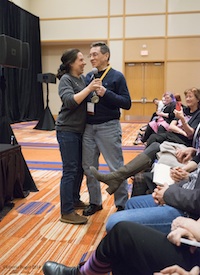
ADC with Zoe Strauss, SPE, Baltimore, March 7, 2014. Photo © by Harris Fogel.
Susan kae Grant got the Honored Educator award right after that, and then Zoe Strauss delivered a bang-up lecture about a community project she’d orchestrated. When I raised my hand afterward to make a comment on her presentation, she jumped down off the low stage and surprised me with a hug. I managed to wear the medal for all of forty minutes before putting it back in its little plastic case.
My goodness. I’ll probably make that my last SPE; what could top this? Old and new friends, old (and perhaps new) antagonists and enemies, old and new colleagues, an ex-lover, a roomful of people who grew up in photography reading me, applause, and 40-some years of memories, many happy, some not so much. I rode the bus back to New York with a line from John Le Carré bouncing around in my brain: “There are moments that are made up of too much stuff to be lived at the time they occur.”
•
This post supported by a donation from the Estate of Lyle Bongé.


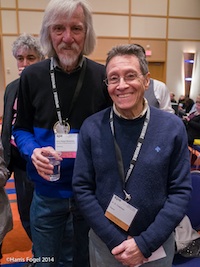




Leave a Comment